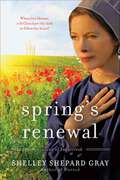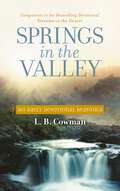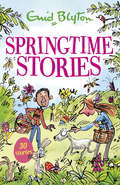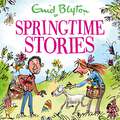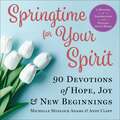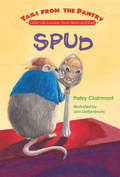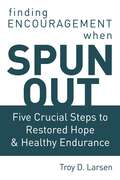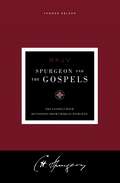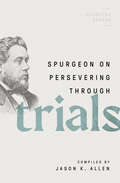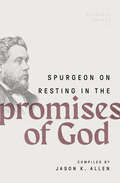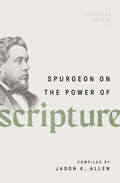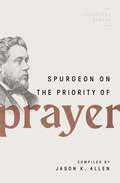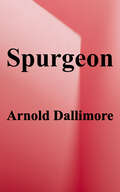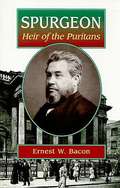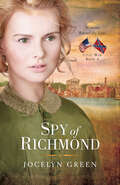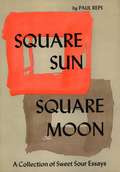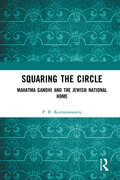- Table View
- List View
Spring's Gentle Promise (Seasons of the Heart #4)
by Janette OkeIn the dimness of the early morning, I could see field after neighborhood field as I let my gaze wander. First there was ours -- I supposed I would always think of the farm as Grandpa's, Uncle Charlie's and mine; though in truth it was just mine now. Guess that was one of the reasons I was whistling. Just yesterday they had signed all the official papers to make the farm mine -- really and legally mine. Joshua Chadwick Jones they read, clear as could be. The full impact had yet to hit me. But I was excited. Really excited. I mean, what other fella my age had a farm of his own, title clear and paid for?
Spring's Renewal: Seasons Of Sugarcreek, Book Two (Seasons of Sugarcreek #2)
by Shelley Shepard GrayIn New York Times bestselling author Shelley Shepard Gray’s Spring’s Renewal, a wounded soul finds hope, healing, and love where she least expected.Bearing the scars from a fire during her childhood, Clara has lived a sheltered life. Her only companion has been her widowed mother, who needs Clara as a caregiver. With no faith that her appearance will ever bring true love her way, she has devoted herself to her mother’s health and safety, while also working as Sugarcreek’s schoolteacher.Tim Graber is just passing through, helping out on his uncle’s farm for the spring, when he meets Clara. Attracted by her quiet fortitude and how she nurtures her students, Tim sees Clara’s beauty, not her scars. She is a light in the world, if only he can make her see it.Clara never imagined falling in love and wants nothing more than to give Tim her heart. It’s a risk that requires true faith, especially when a tragedy occurs that changes everything. . . “Gray writes with honesty, tenderness, and depth. Her characters are admirable, richly-layered, and impossible to forget.” —New York Times bestselling author Jillian HartSeasons of SugarcreekWinter’s AwakeningSpring’s RenewalAutumn’s PromiseChristmas in Sugarcreek
Springfield
by Sergio OlguínSergio Olguín vuelve a enamorarnos con una historia sobre el valor de la amistad, la valentía y la pasión por el fútbol. Después de recuperar la pelota de Maradona, Ariel y sus dos amigos viajan a los Estados Unidos como parte de un programa de intercambio cultural con un colegio secundario. Así es que llegan a la ciudad de Springfield con la ilusión de vivir una gran aventura adolescente, de amores, sexo y desenfreno al mejor estilo de la película American Pie. Pero poco a poco comienzan a descubrir que, detrás de la fachada de modernidad y bienestar, acecha la cara más conservadora de una sociedad en extremo religiosa y que, por detrás de los discursos políticamente correctos, afloran los prejuicios, la discriminación y el odio. Esta vez la banda de amigos deberá enfrentarse con un grupo violento, resolver una serie de asesinatos y salvar de la cárcel a una amiga. Pero también habrá espacio para los romances, el humor, las hamburguesas y el encuentro con personajes de lo más extravagantes, de esos que hacen honor a la leyenda de la ruta 66. Un auténtico road trip americano, un viaje iniciático que no olvidarán jamás. Los protagonistas de El equipo de los sueños (Grijalbo, 2022) regresan en un capítulo nuevo, épico, irresistible, que es además un homenaje a la cultura, y a la contracultura, estadounidenses: Los Simpson, los escritores beatniks, Bob Dylan y la NBA.
Springs in the Valley: 365 Daily Devotional Readings
by L. B. CowmanSprings in the Valley has been refreshing to the souls of believers for the past 60 years, and this updated price-conscious edition brings timeless messages of hope to existing fans and new readers alike.In this beautiful updated package, Springs in the Valley will continue to offer refreshment and joy to the thirsty traveler through God&’s Word and L. B. Cowman&’s lilting prose and poetry. Cowman shares cool draughts of wisdom and insight into God&’s character, drawn from the Scriptures and purified through a lifetime of experience. In print for more than 60 years, this beloved daily devotional challenges readers on the themes of hope and renewal. Men and women alike will be drawn to this follow-up to Streams in the Desert.
Springtime Stories: 30 classic tales
by Enid BlytonDelight in this collection of 30 short stories, full of the buzz and excitement of spring!Head off on a sparkling springtime adventure with the world's best-loved storyteller. From the little boy who helps a lamb in trouble to the fairies hidden inside Easter Eggs, excitement and magic are never far away in this collection of stories to read and share. These fun, entertaining tales are ideal for newly confident readers and are the perfect length for reading aloud at bedtime or in the classroom. Enid Blyton remains one of Britain's favourite children's authors and her bumper short story collections are perfect for introducing her to the latest generation of readers.Read all of Enid Blyton's bestselling short story collections: Springtime StoriesSummer StoriesHoliday StoriesSummer Holiday StoriesStories of Wizards and WitchesChristmas TalesChristmas Treats***Enid Blyton ® and Enid Blyton's signature are Registered Trademarks of Hodder & Stoughton Limited. No trademark or copyrighted material may be reproduced without the express written permission of the trademark and copyright owner.
Springtime Stories: 30 classic tales (Bumper Short Story Collections #16)
by Enid BlytonDelight in this collection of 30 short stories, full of the buzz and excitement of spring! Head off on a sparkling springtime adventure with the world's best-loved storyteller. From the little boy who helps a lamb in trouble to the fairies hidden inside Easter Eggs, excitement and magic are never far away in this collection of stories to read and share. These fun, entertaining tales are ideal for newly confident readers and are the perfect length for reading aloud at bedtime or in the classroom. Enid Blyton remains one of Britain's favourite children's authors and her bumper short story collections are perfect for introducing her to the latest generation of readers.Read all of Enid Blyton's bestselling short story collections: Springtime StoriesSummer StoriesHoliday StoriesSummer Holiday StoriesStories of Wizards and WitchesChristmas TalesChristmas Treats***Enid Blyton ® and Enid Blyton's signature are Registered Trademarks of Hodder & Stoughton Limited. No trademark or copyrighted material may be reproduced without the express written permission of the trademark and copyright owner.
Springtime Stories: 30 classic tales (Bumper Short Story Collections #22)
by Enid BlytonDelight in this collection of 30 short stories, full of the buzz and excitement of spring - the perfect Easter present! Head off on a sparkling springtime adventure with the world's best-loved storyteller. From the little boy who helps a lamb in trouble to the fairies hidden inside Easter Eggs, excitement and magic are never far away in this collection of stories. Enid Blyton remains one of Britain's favourite children's authors and her bumper short story collections are perfect for introducing her to the latest generation of readers.(P) 2017 Hodder Children's Books
Springtime for Your Spirit: 90 Devotions of Hope, Joy & New Beginnings
by Michelle Medlock Adams Andy ClappGuaranteed to breathe new life into your walk with God, this 90-day devotional—with entries for March, April, and May—will reawaken your spirit through famous quotes, inspirational readings, meaningful prayers, and targeted scriptures. Whether you&’re looking for those first signs of new life to burst through the soil, hunting Easter eggs with the kiddos, or seeking a closer relationship with Jesus, it seems we&’re all searching for something to bring us hope, joy, and a new beginning. That&’s why Springtime For Your Spirit: 90 Devotions of Hope, Joy, and New Beginnings is the perfect devotional for such a special season. Award-winning authors Michelle Medlock Adams and Andy Clapp have carefully woven biblical lessons into holidays and happenings that we experience only during spring, such as: MLB Spring TrainingLentEasterSpring Storm SeasonSpring Pancake FestivalSpring PlantingMother&’s Day Each devotion not only features an inspirational teaching and quote, but also, it gives readers the opportunity to: Plant the Word, Work the Word,Pray the Word, and learn more through a Did You Know? feature. We challenge you to search the pages of this devotional and experience the sweetness of this sacred season. Your beautiful new beginning awaits. . . .
Spud
by Patsy ClairmontBullies are always a problem, but not when cooperation takes hold in the mouse world of Tails From the Pantry. Soccer, Meatball, and Stinky all work together to teach Spud a lesson, but forgiveness is the lesson from the Tails team.
Spun Out: Five Crucial Steps to Restored Hope and Healthy Endurance
by Troy D. LarsenWe will all find ourselves searching for traction in life's slippery circumstances and situations at some point in our life. For some, that point is very obvious and current, for others, the time will arrive when things appear overwhelming. In Spun Out, Troy D. Larsen encourages us with practical answers and insight when those life experiences invade our lives and leave us questioning how to move forward. When one may appear stunned, at a standstill or loss he encourages that there is a means to hope and endurance. What may appear to be a shipwreck in our life, he explains there could and should be a necessary place of rest and restoration in the process of what he describes as dry-dock. He gives five crucial steps to restored hope and healthy endurance. In Spun Out you will discover:-How hope can and should be restored when feeling hopeless.-How endurance can and should be healthy and seen as necessary.-How to move forward when life seems at a standstill or loss.-What makes an individual life important and valuable when felt devalued.-How to find rest in overextended and overwhelmed circumstances.-How to evaluate what should be consuming our lives.-How to set a healthy life pace.-What is the key to living a balanced lifestyle?-How encouragement functions as a life-giving source. Spun Out is written to encourage, strengthen, build up, and move you forward. Whether you are in a current life challenge or know someone who is in need of encouragement, this writing is sure to bring practical steps and insight.
Spurgeon and the Gospels: The Gospels with Devotions from Charles Spurgeon
by Charles H. Spurgeon&“…these are written that you may believe that Jesus is the Christ, the Son of God, and that believing you may have life in His name&” (John 20:31).Nothing was more important to Charles Spurgeon than the gospel. The &“prince of preachers&” great passion was that all would know and believe that Jesus is the Christ and find eternal life in Him. Let Spurgeon&’s passion for the gospel ignite your own as you read and meditate on Matthew, Mark, Luke, and John in Spurgeon and the Gospels.This devotional edition of the Gospels features a brief extract from Charles Spurgeon's sermons and collected works leading into each chapter of the four Gospels. This beautifully produced edition of the Gospels is a timeless classic that engages readers for years to come.Features include:Devotional thoughts from renowned preacher Charles Spurgeon drawn from his sermons and collected writings provide timeless insights into the GospelsSingle column, verse-by-verse typesetting on a right-hand page with room to journal your own meditationsPresentation page allows you to personalize this special gift by recording a memory or noteSatin ribbon markerClear and readable 9.5 Point NKJV Comfort Print
Spurgeon on Persevering Through Trials (Spurgeon Speaks)
by Jason K. AllenWhen Spurgeon speaks, you&’d be wise to listen.The great London preacher Charles Haddon Spurgeon had a lot to say during his four decades of ministry at the Metropolitan Tabernacle. And beyond his mighty voice, Spurgeon&’s pen churned out countless words of biblical interpretation and Christian wisdom. These words can still encourage us today!Volume 3 of the Spurgeon Speaks series shows you how to stay strong when life is coming at you hard. Spurgeon himself faced trials—physical challenges, harsh criticism, and much more—yet he stayed focused on God&’s call for his life. This book will help you do the same.Presented in lovely editions that you&’ll be proud to have on your shelf, the Spurgeon Speaks series offers focused readings on topics that were important to the Prince of Preachers. Expertly selected by Jason Allen and updated for twenty-first century readers, this series will be a valued addition to the library of pastors, scholars, and anyone who appreciates the legacy of Charles Haddon Spurgeon.
Spurgeon on Persevering Through Trials (Spurgeon Speaks)
by Jason K. AllenWhen Spurgeon speaks, you&’d be wise to listen.The great London preacher Charles Haddon Spurgeon had a lot to say during his four decades of ministry at the Metropolitan Tabernacle. And beyond his mighty voice, Spurgeon&’s pen churned out countless words of biblical interpretation and Christian wisdom. These words can still encourage us today!Volume 3 of the Spurgeon Speaks series shows you how to stay strong when life is coming at you hard. Spurgeon himself faced trials—physical challenges, harsh criticism, and much more—yet he stayed focused on God&’s call for his life. This book will help you do the same.Presented in lovely editions that you&’ll be proud to have on your shelf, the Spurgeon Speaks series offers focused readings on topics that were important to the Prince of Preachers. Expertly selected by Jason Allen and updated for twenty-first century readers, this series will be a valued addition to the library of pastors, scholars, and anyone who appreciates the legacy of Charles Haddon Spurgeon.
Spurgeon on Resting in the Promises of God (Spurgeon Speaks)
by Jason K. AllenWhen Spurgeon speaks, you&’d be wise to listen.The great London preacher Charles Haddon Spurgeon had a lot to say during his four decades of ministry at the Metropolitan Tabernacle. And beyond his mighty voice, Spurgeon&’s pen churned out countless words of biblical interpretation and Christian wisdom. These words can still encourage us today!Volume 4 of the Spurgeon Speaks series helps you find true rest—not mere relaxation, but the lasting peace that arises only out of confidence in God. Spurgeon points you to the biblical promises that God has made. Those words weren&’t just valid for ancient Israelites or a Victorian-era preacher. God&’s eternal promises can give you rest today.Presented in lovely editions that you&’ll be proud to have on your shelf, the Spurgeon Speaks series offers focused readings on topics that were important to the Prince of Preachers. Expertly selected by Jason Allen and updated for twenty-first century readers, this series will be a valued addition to the library of pastors, scholars, and anyone who appreciates the legacy of Charles Haddon Spurgeon.
Spurgeon on Resting in the Promises of God (Spurgeon Speaks)
by Jason K. AllenWhen Spurgeon speaks, you&’d be wise to listen.The great London preacher Charles Haddon Spurgeon had a lot to say during his four decades of ministry at the Metropolitan Tabernacle. And beyond his mighty voice, Spurgeon&’s pen churned out countless words of biblical interpretation and Christian wisdom. These words can still encourage us today!Volume 4 of the Spurgeon Speaks series helps you find true rest—not mere relaxation, but the lasting peace that arises only out of confidence in God. Spurgeon points you to the biblical promises that God has made. Those words weren&’t just valid for ancient Israelites or a Victorian-era preacher. God&’s eternal promises can give you rest today.Presented in lovely editions that you&’ll be proud to have on your shelf, the Spurgeon Speaks series offers focused readings on topics that were important to the Prince of Preachers. Expertly selected by Jason Allen and updated for twenty-first century readers, this series will be a valued addition to the library of pastors, scholars, and anyone who appreciates the legacy of Charles Haddon Spurgeon.
Spurgeon on the Power of Scripture (Spurgeon Speaks)
by Jason K. AllenWhen Spurgeon speaks, you&’d be wise to listen.The great London preacher Charles Haddon Spurgeon had a lot to say during his four decades of ministry at the Metropolitan Tabernacle. And beyond his mighty voice, Spurgeon&’s pen churned out countless words of biblical interpretation and Christian wisdom. These words can still encourage us today!Volume 2 of the Spurgeon Speaks series focuses on the power of God&’s Word. Nothing motivated Spurgeon more than proclaiming the holy Scriptures. His love for the Bible will encourage you as well. Presented in lovely editions that you&’ll be proud to have on your shelf, the Spurgeon Speaks series offers focused readings on topics that were important to the Prince of Preachers. Expertly selected by Jason Allen and updated for twenty-first century readers, this series will be a valued addition to the library of pastors, scholars, and anyone who appreciates the legacy of Charles Haddon Spurgeon.
Spurgeon on the Power of Scripture (Spurgeon Speaks)
by Jason K. AllenWhen Spurgeon speaks, you&’d be wise to listen.The great London preacher Charles Haddon Spurgeon had a lot to say during his four decades of ministry at the Metropolitan Tabernacle. And beyond his mighty voice, Spurgeon&’s pen churned out countless words of biblical interpretation and Christian wisdom. These words can still encourage us today!Volume 2 of the Spurgeon Speaks series focuses on the power of God&’s Word. Nothing motivated Spurgeon more than proclaiming the holy Scriptures. His love for the Bible will encourage you as well. Presented in lovely editions that you&’ll be proud to have on your shelf, the Spurgeon Speaks series offers focused readings on topics that were important to the Prince of Preachers. Expertly selected by Jason Allen and updated for twenty-first century readers, this series will be a valued addition to the library of pastors, scholars, and anyone who appreciates the legacy of Charles Haddon Spurgeon.
Spurgeon on the Priority of Prayer (Spurgeon Speaks)
by Jason K. AllenWhen Spurgeon speaks, you&’d be wise to listen.The great London preacher Charles Haddon Spurgeon had a lot to say during his four decades of ministry at the Metropolitan Tabernacle. And beyond his mighty voice, Spurgeon&’s pen churned out countless words of biblical interpretation and Christian wisdom. These words can still encourage us today!Volume 1 of the Spurgeon Speaks series collects Spurgeon&’s reflections and meditations on the importance of prayer in the Christian life. He was known as a mighty man of prayer, and his insights will deepen your prayer life as well.Presented in lovely editions that you&’ll be proud to have on your shelf, the Spurgeon Speaks series offers focused readings on topics that were important to the Prince of Preachers. Expertly selected by Jason Allen and updated for twenty-first century readers, this series will be a valued addition to the library of pastors, scholars, and anyone who appreciates the legacy of Charles Haddon Spurgeon.
Spurgeon on the Priority of Prayer (Spurgeon Speaks)
by Jason K. AllenWhen Spurgeon speaks, you&’d be wise to listen.The great London preacher Charles Haddon Spurgeon had a lot to say during his four decades of ministry at the Metropolitan Tabernacle. And beyond his mighty voice, Spurgeon&’s pen churned out countless words of biblical interpretation and Christian wisdom. These words can still encourage us today!Volume 1 of the Spurgeon Speaks series collects Spurgeon&’s reflections and meditations on the importance of prayer in the Christian life. He was known as a mighty man of prayer, and his insights will deepen your prayer life as well.Presented in lovely editions that you&’ll be proud to have on your shelf, the Spurgeon Speaks series offers focused readings on topics that were important to the Prince of Preachers. Expertly selected by Jason Allen and updated for twenty-first century readers, this series will be a valued addition to the library of pastors, scholars, and anyone who appreciates the legacy of Charles Haddon Spurgeon.
Spurgeon: A New Biography
by Arnold DallimoreIt is no easy task to depict 'so tremendous a personality' as that of Spurgeon in a brief volume, but in 250 pages it is here accomplished, and with a large measure of success. It will meet the need of those completely ignorant of Spurgeon and his vast achievements, but will stir also the interest of all who value a unique ministry, yielding 62 volumes of 'deathless' sermons and many other highly valuable publicatons.
Spurgeon: Heir of the Puritans
by Ernest W. BaconA biography of Charles Haddon Spurgeon written by a man whose parents were contemporaries of Spurgeon himself.
Spy of Richmond (Heroines Behind The Lines Ser.)
by Jocelyn GreenWhen living a lie is the right thing to doThe Confederate capital in the height of the Civil War: no place for a Union loyalist. But just the place for a spy. Her father a slaveholder, her suitor a Confederate officer, and she an abolitionist, Sophie Kent must walk a tightrope of deception in her efforts to end slavery. As suspicion in Richmond rises, Sophie&’s espionage becomes more and more dangerous. If her courage will carry her through, what will be lost along the way—her true love, her father, her life?Series note:Spy of Richmond is a work of fiction inspired by first-person accounts of Union loyalists and Confederates living in Richmond during the Civil War. This is the fourth and last book in the series Heroines Behind the Lines: Civil War, which offers an inside look at women&’s contributions during times of war. For more information about the series, visit heroinesbehindthelines.com.
Spy of Richmond (Heroines Behind The Lines Ser.)
by Jocelyn GreenWhen living a lie is the right thing to doThe Confederate capital in the height of the Civil War: no place for a Union loyalist. But just the place for a spy. Her father a slaveholder, her suitor a Confederate officer, and she an abolitionist, Sophie Kent must walk a tightrope of deception in her efforts to end slavery. As suspicion in Richmond rises, Sophie&’s espionage becomes more and more dangerous. If her courage will carry her through, what will be lost along the way—her true love, her father, her life?Series note:Spy of Richmond is a work of fiction inspired by first-person accounts of Union loyalists and Confederates living in Richmond during the Civil War. This is the fourth and last book in the series Heroines Behind the Lines: Civil War, which offers an inside look at women&’s contributions during times of war. For more information about the series, visit heroinesbehindthelines.com.
Square Sun Square Moon: A Collection of Sweet Sour Essays
by Paul RepsThis collection of Zen essays by the author of Zen Flesh, Zen Bones offers an enlightening perspective on a variety of topics.From the introduction:Not all of us can be exuberant travelers though we all dream of faraway places. <P><P>Not all of us can sec the subliminal with a penetrating eye, though many of us yearn to shake off the philistine shells that restrict our lives to the prosaic.Here, then, is your chance! In the privacy of your den, on the commode, in the library wherever you find reading most pleasurable reps invites you t o share his experiences vicariously. Within these pages, if you synchronize properly, you may find yourself in Tahiti where you "breathe this flowered air, drink the cascading water, cat the fruits and just sleep" until "you too become sweet."
Squaring the Circle: Mahatma Gandhi and the Jewish National Home
by P. R. KumaraswamyThe centrality of the book is Gandhi's disposition and orientation towards the idea of Jewish homeland. When it comes to Jews, Jewish nationalism and their aspirations in Palestine, even Mahatma Gandhi was not infallible. His abiding empathy for the Jews was negated by his limited understanding of Judaism and Jewish history. His perception of the Palestine issue and his support for the Arabs was rooted in the domestic Indian context. The conventional understanding that Gandhi was ‘consistently’ opposed to Zionism and the Jewish aspirations for a national home in Palestine does not correspond with his later remarks. While demanding Jewish non-violence both against Hitler and in Palestine, Mahatma was prepared to understand, the ‘excesses’ of the Arabs who were facing ‘overwhelming odds.’ His position on the domestic situation largely influenced his stand viz-à-viz Palestine and hence his demand for Jews to abandon their collaboration with imperialism and follow the path of negotiation should be read within the Indian context. So long as India pursued a recognition-without-relations policy toward Israel, one could rest on Gandhi’s shoulders and adopt a self-righteous attitude. However, can one rely on the Gandhian paradigm to explain India’s new-found bonhomie toward Israel without sounding selective, hypocritical or both? The primary focus of this book is the explication of political constraints and oversensitivity towards the religious minority for political gains, which shaped Gandhi's notion about the Jewish homeland. The author has conducted an empirical survey of the political, religious and strategic constraints behind Gandhi's idea of the Jewish homeland that in common parlance is seen as an ardent disapproval of Zionism by Gandhi. Please note: This title is co-published with KW Publishers, New Delhi. Taylor & Francis does not sell or distribute the Hardback in India, Pakistan, Nepal, Bhutan, Bangladesh and Sri Lanka

